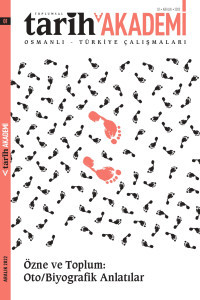Tarihsel Bir Belge Olarak Harita ve Geç Osmanlı İskenderun Haritaları’nın Bize Söyledikleri
Bu makale mekânsal ilişkileri odağına alan mimarlık tarihi ve mimarlık disiplinleri için en değerli kaynaklardan biri olan haritaların kullanımına eleştirel bir bakış getirmeyi hedefliyor. Özellikle 1970lerde temelleri atılmış, bugün hala mimarlık ve mimarlık tarihi alanlarında yoğunlukla kullanılan Mekan Dizimi (Space Syntax) yöntem ve teorisine odaklanan makale, bu yöntemin haritaları morfolojik (biçimbilimsel) analizler yapmak üzere birer ‘altlığa’ indirgediğini savunuyor. Doğuşu harita/haritacılık tarih ve teorisinin sosyo-kültürel dönüşümünden hemen önceye, bilimsellik ve ‘gerçeklik’ iddiasının en kuvvetli olduğu döneme denk gelen Mekan Dizimi yöntem ve teorisi, haritaların kendilerine özgü ağlarını yok sayarak bir yandan yanlış çıkarımlar yapmaya yol açarken diğer yandan haritaların belge olarak sunabileceklerini de ıskalıyor. 1896, 1901 ve 1916 yıllarına ait İskenderun haritaları üzerinden, haritaların başka insanlar, süreçler ve materyaller ile kurdukları ilişkilerin bir asamblaj içinde değerlendirildiğinde bizlere neler sunabileceğine dair küçük bir pencere açmayı amaçlayan bu makale, aynı zamanda onları altlığa indirgemenin sorunlarını irdeliyor. Haritaların hangi koşullarda, hangi amaçlarla ve neler ile ilişki içinde üretildikleri incelendiğinde, Actor-Network Teorisi’nin önerdiği gibi, alışık olmadığımız aktörlerin aktif rollerinin gözler önüne serileceği ve beklentimizin ötesinde bir şeyler ortaya çıkarabileceğinin altı çiziliyor.
Anahtar Kelimeler:
Harita Tarihi, Mekan Dizimi, Kent Tarihi, İskenderun, Geç Osmanlı
Maps as Historical Sources and What Late Ottoman Iskenderun Maps Reveal
This article aims to take a critical glance at the use of maps in spatially focused disciplines such as architecture and architectural history. It concentrates specifically on Space Syntax methodology and theory, founded in the 1970s and still used extensively in architecture and architectural history fields. The main argument elaborates on Space Syntax’s use of maps which reduces them to ‘underlays’ to analyze spatial relations morphologically and by doing so misses other potentials that maps have to offer as sources. The emergence of Space Syntax theory goes hand in hand with map/mapping history and theory’s claims of being scientific and depicting the ‘truth’, right before its socio-cultural turn in the 1980s. The highly quantitative methods used by Space Syntax make use of maps to create various diagrams for spatial analyses, which ignores the unique network of each map in terms of its production and circulation. By scrutinizing the 1896, 1901, and 1916 maps of İskenderun (Alexandretta) within their own assemblage - meaning through their relations with human and non-human actors - this article aspires to glimpse at what maps have to offer and what goes wrong when we reduce them to underlays. Following what Actor-Network Theory suggests, it proposes to investigate the production processes and purposes of maps as well as their unique ties to unravel the active roles of those actors that we’re usually not accustomed to.
Keywords:
Map History, Urban History, Space Syntax, Alexandretta, Late Ottoman,
___
- Bafna, Sonit “Space Syntax: A Brief Introduction to Its Logic and Analytical Techniques.” Environment and Behavior 35, No. 1 (January 2003): 17-29.
- Beşirli, Mehmet. “Bağdat Demiyolu’nun Akdeniz Uzantısı: Toprakkale- İskenderun Demiryolu.” A.Ü. Türkiyat Araştırmaları Enstitüsü Dergisi 23 (2004): 215-236.
- Corner, James. “The Agency of Mapping: Speculation, Critique, and Invention”, The Landscape Imagination: Collected Essays of James Corner 1990-2010, der. James Corner ve Alison Bick Hirsch, 89-101. New York: Princeton Architectural Press, 2014.
- Edney, H. Matthew. “Academic Cartography, Internal Map History, and the Critical Study of Mapping Processes.” Imago Mundi: The International Journal for the History of Cartography 66, No.1 (2014): 83-106.
- Eroğlu, Cengiz, Murat Babuçoğlu ve Mehmet Köçer, der. Osmanlı Vilayet Salnamelerinde Halep. Ankara: ORSAM, 2012.
- Griffiths, Sam ve Laura Vaughan, “Mapping Spatial Cultures: Contributions of Space Syntax to Research In The Urban History Of The Nineteenth- Century City.” Urban History 47 (2020): 488-511.
- Griffiths, Sam. “The Use of Space Syntax in Historical Research: Current Practice and Future Possiblities”, Proceedings: Eighth International Space Syntax Symposium, der. M. Greene, J. Reyes ve A. Castro. Santiago de Chile: PUC, 2012. 8193: 1-26.
- Harley, Brian J. “Deconstructing the Map,” Cartographica 26, No.2 (Summer 1989): 1-20.
- Hillier, Bil ve Julienne Hanson, The Social Logic of Space. Cambridge: Cambridge University Press, 1984. Hillier, Bill. “In Defense of Space”, RIBA Journal (1973): 539 - 544.
- Kitchin, Rob, Chris Perkins ve Martin Dodge, “Thinking About Maps”, Rethinking Maps, der. Martin Dodge, Rob Kitchin ve Chris Perkins, 1-25. London: Routledge, 2009.
- Klarqvist, Björn. “A Space Syntax Glossary.” Nordisk Arkitekturforskning 2 (1993): 11-12.
- Lafi, Nora. “Urban Infrastructure between Local Networks and the Wider World: The Tramway in Late-Ottoman Aleppo.” From the Household to the Wider World, der. Yuval Ben-Bassa ve Johann Buessow, 207-222. Tübingen: Tübingen University Press, 2022.
- Oliveira, Vitor. “Urban Morphology”, Oxford Bibliographies, son güncelleme 15 Ekim 2020, https://www.oxfordbibliographies.com/display/document/obo-9780190922481/obo-9780190922481-0004.xml
- Ürkmez, Naim “Tanzimat’tan I. Dünya Savaşı’na İskenderun.” Basılmamış Doktora Tezi, Atatürk Üniversitesi, 2012.
- ISSN: 2979-966X
- Başlangıç: 2022
- Yayıncı: Tarih Vakfı
Sayıdaki Diğer Makaleler
Demiryolları Çalışmalarında Yeni ve Eskimeyen Perspektifler
Tarihsel Bir Belge Olarak Harita ve Geç Osmanlı İskenderun Haritaları’nın Bize Söyledikleri
Cavit Orhan Tütengil ve Türkiye’nin Karayolları
Su, Çevre, Sanayi ve Devlet: Modernleşme Sürecinde Bursa Kentinin Suyunu ‘Sıhhileştirmek’
Tabiat, Tahayyül ve Tahakküm: Erken Cumhuriyet Döneminde İdeoloji, Su ve Ulus İnşası
Osmanlı’nın İlk Demiryolu Tecrübesi: İzmir-Aydın Hattının Zorlu Yılları
Galata’da Uluslararası Ticareti Mektup Zarflarından Okumak
